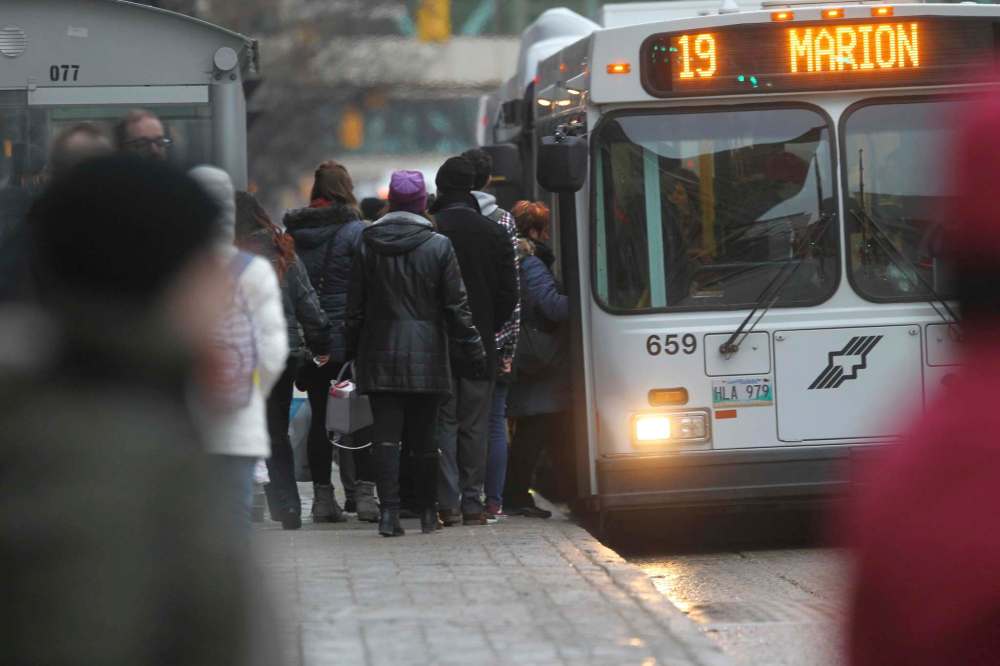More people take bus to work: stats
Advertisement
Read this article for free:
or
Already have an account? Log in here »
To continue reading, please subscribe:
Monthly Digital Subscription
$0 for the first 4 weeks*
- Enjoy unlimited reading on winnipegfreepress.com
- Read the E-Edition, our digital replica newspaper
- Access News Break, our award-winning app
- Play interactive puzzles
*No charge for 4 weeks then price increases to the regular rate of $19.00 plus GST every four weeks. Offer available to new and qualified returning subscribers only. Cancel any time.
Monthly Digital Subscription
$4.75/week*
- Enjoy unlimited reading on winnipegfreepress.com
- Read the E-Edition, our digital replica newspaper
- Access News Break, our award-winning app
- Play interactive puzzles
*Billed as $19 plus GST every four weeks. Cancel any time.
To continue reading, please subscribe:
Add Free Press access to your Brandon Sun subscription for only an additional
$1 for the first 4 weeks*
*Your next subscription payment will increase by $1.00 and you will be charged $16.99 plus GST for four weeks. After four weeks, your payment will increase to $23.99 plus GST every four weeks.
Read unlimited articles for free today:
or
Already have an account? Log in here »
Hey there, time traveller!
This article was published 01/12/2017 (2925 days ago), so information in it may no longer be current.
The number of Winnipeggers using public transit to commute to work is steadily going up, Statistics Canada figures released this week show.
In 2006, 44,975 Winnipeggers said they used public transit to get to work — about 13 per cent of the 346,790 respondents.
In 2011, 48,905 Winnipeggers said they used public transit to get to work — about 13.4 per cent of the 364,745 respondents.

In 2016, 51,395 Winnipeggers said the same — about 13.6 per cent of the 377,845 respondents.
The average commute time for a Winnipegger using any sort of transportation was 35.7 minutes. The Statistics Canada results come as Winnipeg Transit faces a budget cut and service reduction.
Winnipeg Transit is going to be $10.7 million over budget for the year, mostly because of an unexpected shortfall in provincial funding.
The 2018 civic budget proposes a 25-cent fare hike and service reductions to make up for the deficit. Council will vote on the budget Dec. 12. Advocacy groups have decried the proposed fare hike and service cuts.
“The city has a responsibility to keep up,” said Joseph Kornelson, chairman of the advocacy group Functional Transit Winnipeg.
Kornelson thinks the data show that although there has been a slight decrease in transit ridership since 2013, according to Winnipeg Transit, the number of Winnipeggers who rely on transit for their daily commute is still significant.
“Maybe we’ve lost a few riders in the past few years, but the ridership is still way higher than 10 years ago,” Kornelson said, pointing to data collected by the United Way of Winnipeg in 2014 that shows a steady increase in ridership since 2003.
But it’s not all doom and gloom. On average, more Winnipeggers use public transit than Canadians overall, with the national average sitting at 12.4 per cent compared with Winnipeg’s 13.6 per cent.
In Edmonton — a city that spends 13.1 per cent of its $2.5-billion biannual budget on city-owned public transit, both light rail and bus — only 11.3 per cent of commuters used public transit to get to work, with an average commute of 40.2 minutes.
Mayor Brian Bowman’s office said he hadn’t yet reviewed the latest census data.
— with files from Aldo Santin
erik.pindera@freepress.mb.ca

Erik Pindera is a reporter for the Free Press, mostly focusing on crime and justice. The born-and-bred Winnipegger attended Red River College Polytechnic, wrote for the community newspaper in Kenora, Ont. and reported on television and radio in Winnipeg before joining the Free Press in 2020. Read more about Erik.
Every piece of reporting Erik produces is reviewed by an editing team before it is posted online or published in print — part of the Free Press‘s tradition, since 1872, of producing reliable independent journalism. Read more about Free Press’s history and mandate, and learn how our newsroom operates.
Our newsroom depends on a growing audience of readers to power our journalism. If you are not a paid reader, please consider becoming a subscriber.
Our newsroom depends on its audience of readers to power our journalism. Thank you for your support.
History
Updated on Friday, December 1, 2017 2:06 AM CST: Adds photo


